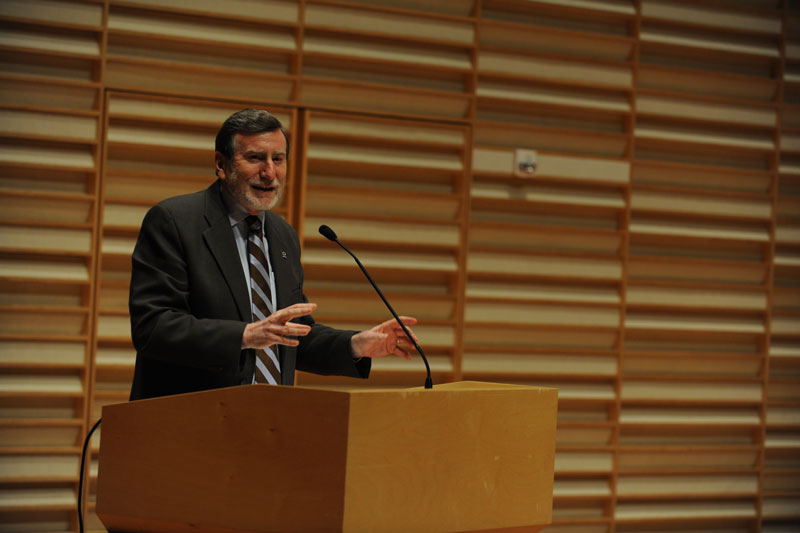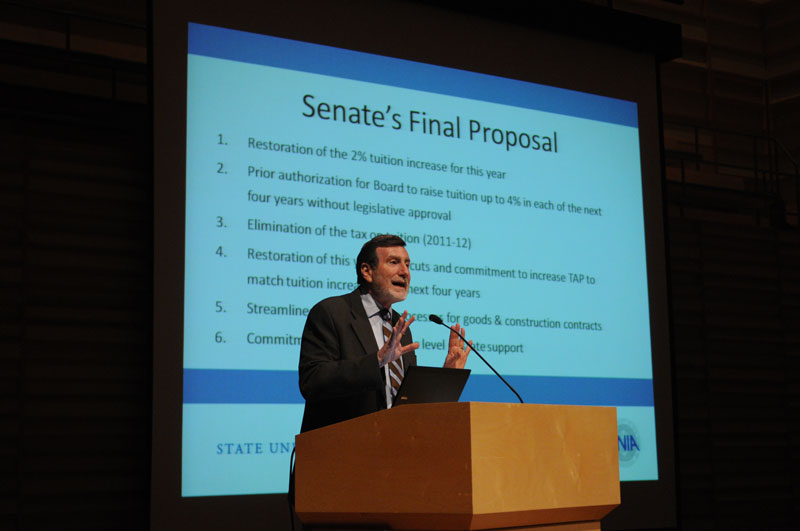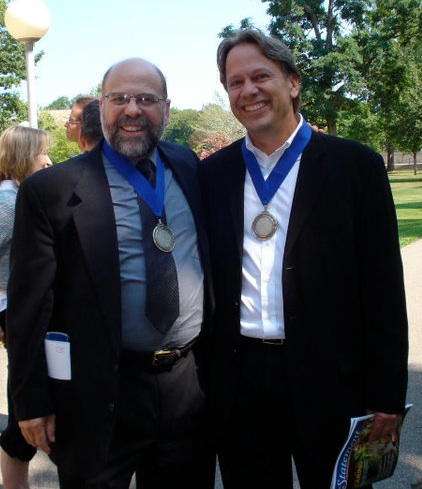Remarks by President Dennis L. Hefner at the General Campus meeting on Friday, August 20, 2010
Welcome back for the start of another very interesting year. We will elect a new Governor in November; the state will cut an additional $7 billion during the next year; and a rational approach to tuition might actually be in the offing, thanks to the herculean efforts of Chancellor Nancy Zimpher. We truly live in very interesting times.
I hope all of you had a chance to visit with family during the summer break. Jan and I visited our grandchildren in Austin, Texas, where 11-year-old Jillian fast pitched a softball game and hit two triples; grandson Callahan, who is 7-years-old today, set several pool records at a regional swim meet; and 4-year-old Caitlin made new little friends wherever she went. Jan and I boiled under the 100-plus degree Texas sun, but loved every minute of it.
 President Dennis L. Hefner welcomes university employees back to campus at the annual All-Campus Address, held Friday, Aug. 20, in the Juliet J. Rosch Recital Hall. |
The move back into Maytum Hall has been delayed. Budget fighting in Albany slowed approval for the second phase of the Maytum renovation, so we used that time to alter the contract to add sprinklers throughout the building. Sprinklers make the building safer, and will be worth the extra delay.
This past summer saw our second successful May Term, two summer sessions, numerous youth camps, six summer Orientation sessions, and many renovations to academic buildings. Residence halls saw new windows; bathrooms; remodeled lobby and front areas; plus addressable fire alarm systems throughout. The campus-wide Facilities Master Plan made good progress, designs for the upcoming Williams Center renovation are nearly complete, and architects were selected to design the new addition to the Rockefeller Arts Center and the new Blue Devil Fitness Center planned for the old Dods Hall swimming pool area. All of this is good news.
Even better news, especially for Director Judy Metzger who has patiently waited eight years, was yesterday’s official ribbon-cutting for the new and impressive Campus and Community Children's Center. Beginning Monday, the center will add much needed child care services for both infants and children aged 1 to 2, who are called “waddlers.” Another ribbon-cutting will be held later this semester to dedicate the new rehearsal wing to our School of Music’s Mason Hall complex.
However, the most talked about construction project continues to be the new, $60 million Science Center, which goes out for construction bids later this semester. Ground breaking should occur in March 2011, and I can hardly wait.
The Princeton Review again placed us among the top universities in the Northeast, and on Tuesday, U.S. News and World Report ranked us 10th among public regional universities in the North. Another summer honor involved SUNY Fredonia being named a “Great College to Work For” by the Chronicle of Higher Education.
For the third consecutive year, student applications set an all-time record. Much of the application increase involved students of color. Five years ago we established a very ambitious goal to enroll 210 new students of color for Fall 2010 — the “210 by 2010” goal, more than doubling the diversity of our entering class in just five years. On July 12, for the very first time, we surpassed 200 paid deposits by students of color; and on August 1, we had reached 205. I’m anxiously awaiting Monday’s report, but even if we fall one or two deposits short, I’m very grateful for the campus-wide effort that has gone into improving our student diversity.
Now it’s time to talk about the budget and, of course, the Empowerment Act. To put some energy behind this topic, I’ve enlisted the help of the SUNY Fredonia cheerleaders.
[The cheerleaders led the auditorium full of employees in a custom-created “Empowerment” cheer... loud enough, as President Hefner — with pom-poms in hand — instructed, to be heard in Albany.]
 President Hefner reviews the final, scaled-back proposal which the State Senate submitted to the Assembly in an attempt to create a compromise solution for the Empowerment Act. The Assembly did not approve this version either. |
- Restoration of the 2 percent tuition increase for this year;
- Prior authorization for the SUNY Board to raise tuition by up to 4 percent in each of the next four years without legislative approval;
- Elimination of the tax on tuition, effective academic year 2011-12;
- Restoration of the TAP cuts for this year and a commitment to increase TAP to match SUNY tuition increases over the next four years;
- Streamlined procurement processes for goods and for construction contracts; and
- A commitment to maintain the same level of state support.
- The Statement alumni magazine’s new format won the Platinum “best of show” award from the Buffalo Niagara Chapter of the Public Relations Society of America.
- Two students were awarded the first ever student Fulbright awards received by Fredonia students—one went to Andorra and the other, Turkey.
- Junior Nick Guarino was the Division III national champion in both the indoor and outdoor mile.
- The spring musical, “Kiss Me, Kate,” received rave reviews.
- Dr. Ted Schwalbe and Nefin Dinc, both from Communication, collaborated on a U.S. State Department-funded, “Youth Filmmaking in Turkey,” project that brought 15 young Turkish filmmakers to our campus and resulted in several international screenings.
- The Financial Aid Office completed the transition to the federal direct lending program in record time.
- Our Educational Development Program reached a new milestone with a 91percent freshmen to sophomore retention rate.
- The first year of the SEMILLAS grant, one of only 20 grants awarded nationally by Wal-Mart, saw 15 of 17 Latino Dunkirk senior participants decide to enter college this fall.
- The Career Development Office won two awards at the SUNY Career Development Annual Conference: one for Excellence in Internship Programming and another for the use of Technology in Career Related Services.
- Distinguished Professor Alberto Rey, Visual Arts and New Media, had work accepted into an “Art in Embassies Exhibition” that for eight months is on display in the U.S. Embassy at Vatican City.
- The campus Internet Marketplace is growing rapidly, and now has over 30 stores open.
- The Annual Campus Sustainability Report showed our campus making significant strides towards “Going Green.”
- The FACE Center developed extensive opportunities for service learning and partnered with over 50 community organizations, over 70 affiliated businesses, and more than 1,000 community members.
- Park and Ride Express Shuttle expanded to two routes and set a record with over 24,000 riders.
- The Fredonia College Foundation raised $2,211,925 — the third best total in Fredonia’s history, despite the difficult overall economy.
- The Technology Incubator, dedicated in December 2009, currently has 11 clients in residence, and already is one year ahead of its business plan.
- The College of Education received approval for three new academic programs: Early Childhood/Childhood dual certification, the Intensive Teacher Institute Bilingual program, and the School District Leadership program.
- Online education continued to grow with 48 class sections enrolling 731 students.
- Vice President for Administration Tracy Bennett was named the Business Club’s 2010 Business Person of the Year.
- Dr. Birger Vanwesenbeeck, English, and former archivist Jeremy Linden co-hosted an international conference on the Austrian writer Stefan Zweig that showcased Reed Library’s extensive holding of Zweig archival materials.
- Student fundraising projects set new marks as the “Walk for Life” for the American Cancer Society raised more than $30,000 and the Up 'til Dawn fundraiser for St. Jude Children’s Hospital surpassed $10,000 at its inaugural event — both campus records.
- The Fredonia School of Music and Potsdam’s Crane School of Music presented a well-received joint program at the Winter Conference of the New York State School Music Association. Included in the program were several arias from last fall’s magnificent production of “La Boheme,” which received a special standing ovation from appreciative teachers who were attending the conference.
|
See full article>> |
- John Kijinski, Dean, College of Arts and Sciences
- Roger Byrne, Associate Dean, Arts and Sciences
- Ingrid Johnston-Robledo, Assistant Dean, Arts and Sciences
- Thomas Loughlin, Chair, Department of Theatre and Dance
- Beez Schell, Chair, Department of Sports Management and Exercise Sciences
- H. Joseph Straight, Chair, Department of Mathematical Sciences
- Reneta Barneva, Chair, Department of Computer and Information Sciences
- Xiao Zhang, Director, Institutional Studies and Research
- David White, Director, Educational Development Program
Faculty promotions include:
- James Piorkowski, Music
Distinguished Teaching Professor
- Thomas Loughlin, Theatre and Dance
- James Ivey, Theatre and Dance
- Theodore Lee, Biology
- Adrienne McCormick, English
- Kim Tillery, Communication Disorders and Sciences
- Cindy Bird, Language, Learning and Leadership
- Sean Duggan, Music
- Natalie Gerber, English
- Matthew Gronquist, Chemistry
- Kathleen Lesniak, Curriculum and Instruction
- Kate Mahoney, Language, Learning and Leadership
- Jennifer Moon Ro, Language, Learning and Leadership
- Peter Reinelt, Economics
- Lisa Rittelmann, Visual Arts and New Media
- Charles Stoddart, Language, Learning and Leadership
- Dawn Eckenrode
Other promotions include:
- Tammy Bankoski
- Dawn Hunt
- Sharon Markham
- Leah Betts
- Timothy Bentham
- Duane Blakely
- Darlene Burchett
- Randy Goodemote
- Elizabeth Kujawa
- Wayne Dorler
- James Kuras
- James Foringer
- Arthur Franklin
- Justin Jacques
- Shannon McKoon
- Lisa Melohusky
- Rebecca Nalepa
- David Thompson
- Nelson White




